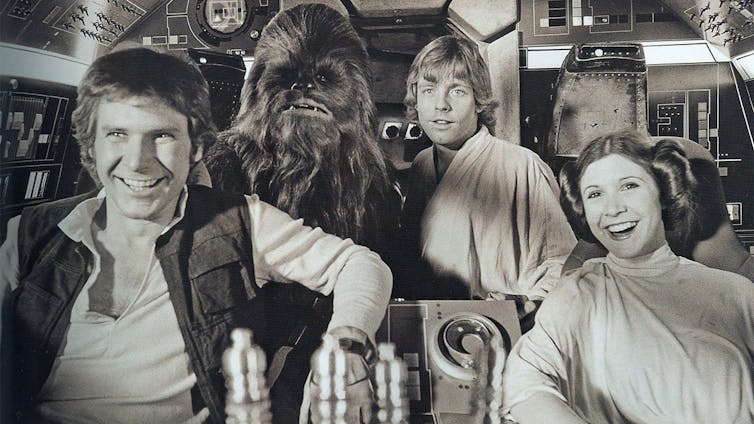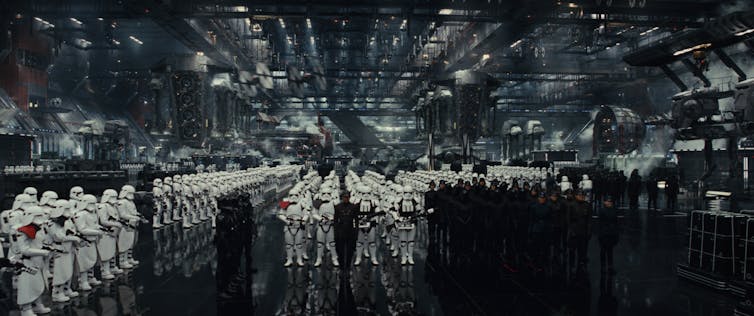$1
That’s what it cost 14-year-old me to get into the 1977 Star Wars premiere.
$10
That’s how much I eventually stole from my mom so I could see it again and again.
I’m not ashamed to admit, as a 14-year-old boy, I was hooked. Standing along side Luke and Obi-Wan, I left this world. Joining Chewie, Leia and Han, I was lifted out of my excruciatingly boring Terran childhood and transported to galactic adventure, far far away. To be frank, it was an opiated pleasure hit that gave me a temporary way out.
Like a lot of people, and for the several decades since 1977, I didn’t realize I was addicted. I’m tempted to say that Jar Jar Binks — the most existentially annoying creature in all of cinematic history, according to some — was the rock-bottom that snapped me out of it, but not really. Even Anakin’s “burn scene” was not enough, though it did get me thinking that something wasn’t right.

Like many, the author was hooked on Star Wars.
(Lucasfilm/Disney)
Honestly, it was a decade later, after I examined the Western Tarot, (an 18th century deck of 78 cards created by Freemasons), that I realized the remarkable potentials of mystical experience, and met a
prophet and mystic by the name of Zoroaster that I finally figured it out. Star Wars is a carefully crafted religious experience.
For me, going to a Star Wars film was just like going to church on Sunday, only I was never addicted to church.
Now, before you go all “Jedi” on me, allow me to explain. Star Wars has the same core ideas as Zorastrianism, which is arguably this world’s first “revealed” religion. A “revealed” religion is a religion that derives from mystical connection.
You see my dear padawan (Jedi apprentice), Zoroaster, a Persian mystic, had ongoing mystical experiences — or what I call connection events. Like Moses and his burning bush, or Joseph Smith and his sacred grove, Zoroaster had, according to his followers, revelatory conversations with God.
It’s in those conversations — or rather, in what elite Sasanian priests of the powerful Sasanian Empire said was in those conversations when they wrote them down in the Zoroastrian sacred script known as the Avesta some 14 or so centuries after he died — that you find Star Wars’ religious roots.
Sasanian priests presented the world with several archetypal ideas (or archetypal nodes, as I call them) which they claimed came directly from Zoroaster.
These ideas, which I summarize in a longer article, are present in various forms in all the world’s religions, including my once sacred Star Wars. Because these ancient religious ideas are blatantly present in Star Wars, I conclude that Star Wars is a religion.
The Sasanian nodes most obvious in Star Wars are the idea of an oppositional binary between good and evil, the idea of a cosmic battle between the two, the notion that you have to make a choice and pick a side, and the notion that if you make the right choice you get to enter through the fancy gates and be rewarded at an altar of light. But if you make the wrong choice then, like Anakin Skywalker, it is “fire and brimstone” for you.
$100
That is probably the total amount of money I have paid over the years to see the Star Wars films in theatres, before I realized what was up and stopped supporting the films. Unfortunately though, Star Wars isn’t isn’t the only source of ideology masquerading as entertainment that I’ve dropped money on. Think Game of Thrones or Harry Potter as well. Atheist or true believer, Communist or capitalist, Muslim or Christian, Buddhist or Hindu, or whatever — we have all, through some cherished childhood belief system or some fancied up Hollywood spectacle, inherited many, if not all, of the ancient Sasanian nodes.

(HBO)
Your particular version might be more gentle, more “liberal,” more secular, more science, or more fantasy than another’s version. But whether it is Christ, Luke Skywalker, Harry Potter, Frodo Baggins, Ahura Mazda versus The Devil, Darth Vader, Voldomort, Sauron or Angra Mainyu, we are all exposed. We’ve all absorbed, more or less unconsciously, some (or all) of the ancient Sasanian nodes.
At this point you should be ask yourself the question, “Why would ancient elite priests, medieval Catholic clerics, modern Hollywood directors, and authors like J.K. Rowling be dressing up and retelling an ancient Sasanian story?”
For one, because they don’t know better. For two, because ever since the elite Sasanian priests first codified it, it has become the kind of story that people with a lot of money like to pay for. They like to pay for Churches where priests teach it, they like to pay authors to spend time writing about it, and they like to pay actors, directors and movie crews money to display it all out.
Why?
It is not rocket science.
They do it because it is useful to them in their “civilization building” activities. This ideology, these days expressed in multiple cultural forms — like the Western Tarot — helped (and helps) turn otherwise passive and peaceful people into obedient tools of violence. Elites can then easily wield this population to a) defend their nascent or established civilizations or b) go on expansionist and colonial campaigns.
With the population properly programmed it is a simple matter to get even educated folk to rise up and to aim them in attack or defence. All the ambitious leader of an ancient city state, or a modern nihilistic narcissist, would have to do to get his people to mobilize is paint the target as a heathen, infidel, gay, transsexual, Communist, atheist, feminist, evil or a bad hombre.
If you do that you have an immediate and powerful justification for all sorts of violent action. And that’s bad because, as history has shown, if you tie it into the Sasanian nodes tightly enough, you can get away with just about anything.
This is important, for all of us. Even burning people alive (as they did in the disturbingly common European witch trials), or gassing them in chambers becomes a justifiable action if you can convince yourself just how evil they are.
$1,000
That’s what I think George Lucas owes me in refund for tickets and time wasted watching his show. I walked away from Catholicism when I was eight. If I had wanted the ‘good versus evil, you’re going to burn in a pit of hell fire’ sermon, I would have stayed in church and saved myself time, and some cash.
Honestly, even if I could get that refund, I wouldn’t just leave things at that. I don’t think we, as a species, can go on believing these nodes anymore. It is a question of our planet’s survival.

(Lucasfilm/Disney)
In the past we might have been able to claim civilisation as the prize for playing on this planet’s bloody checker board floor. In the past, we may have been able to conveniently overlook all the trauma as the inevitable consequence of an evolutionary stage of development.
Now, we cannot. These ancient belief systems, which can be easily exploited by, for example, greedy narcissists with childhood trauma and deep-seated daddy issues, prime us all for violence and war. With industrial technologies, the worst that could happen was genocide.
Now we’re talking DNA printing, quantum computers, nanotechnology, and the weaponization of neural networks in murderous terminator bots. And that’s not even to mention the ecological holocaust that scientists say is on the way.
If we keep thinking with these ancient ideas, we’re not going to be able to handle the transition from Industrial to Quantum Age, and we’re not going to be happy with the dystopia and destruction that is going to turn out.
This would be a sad thing to let happen, especially since we stand at the cusp of an automated and an abundant global utopia.
![]() If we can just break free of our spiritual addictions and change our global thinking, maybe we can still save ourselves.
If we can just break free of our spiritual addictions and change our global thinking, maybe we can still save ourselves.
Dr. Mike Sosteric, Associate Professor, Sociology, Athabasca University
This article was originally published on The Conversation. Read the original article.



Leave a Reply